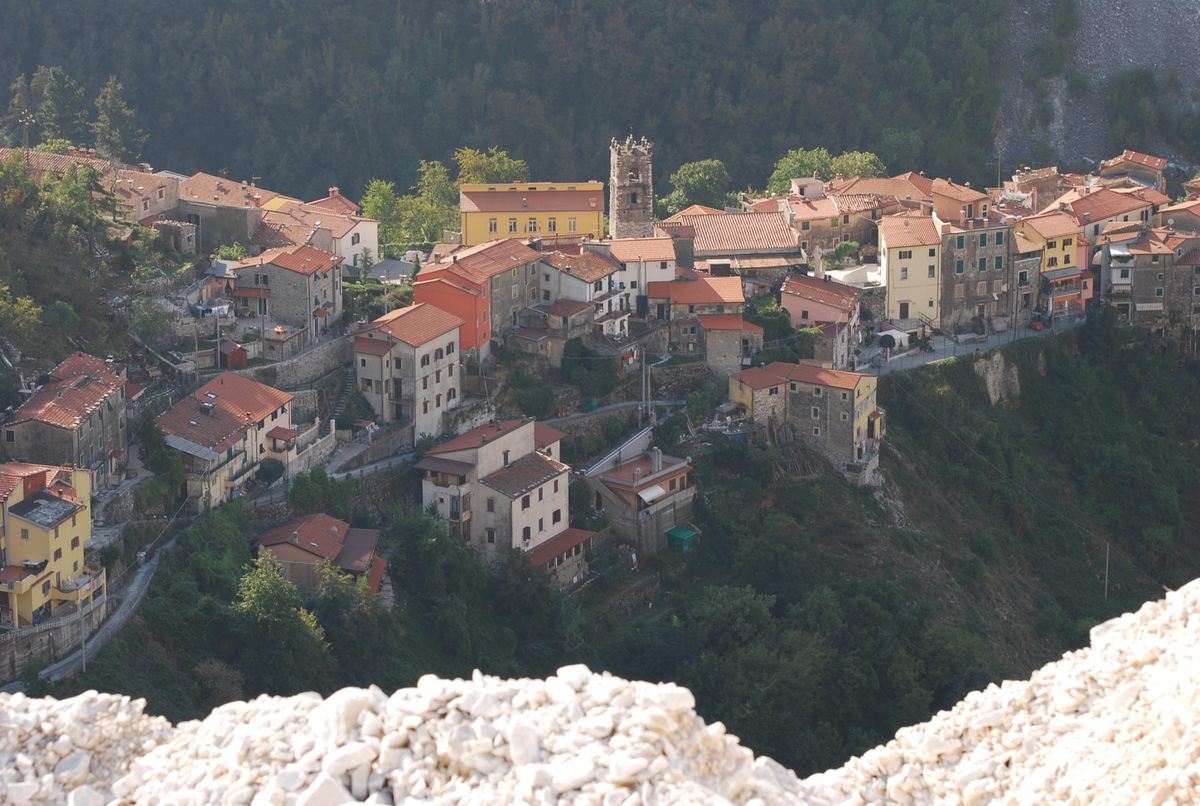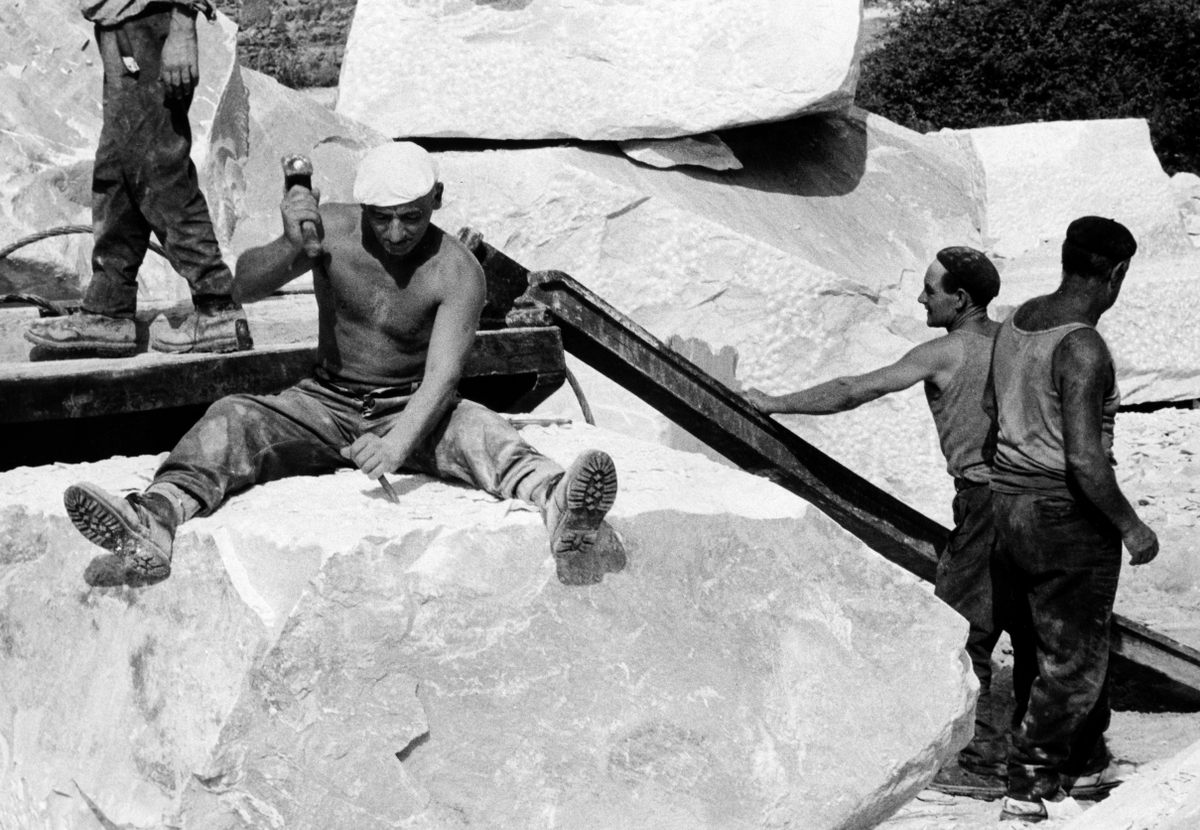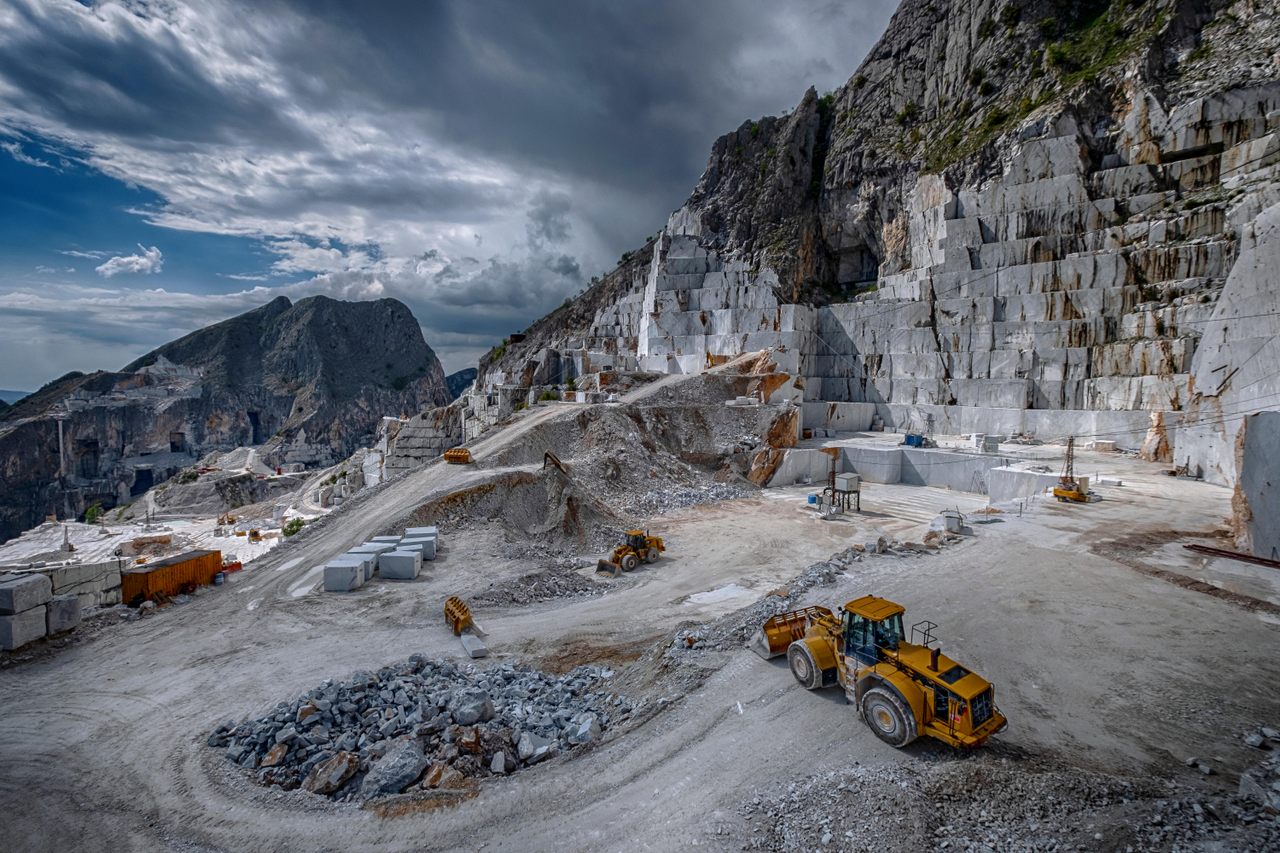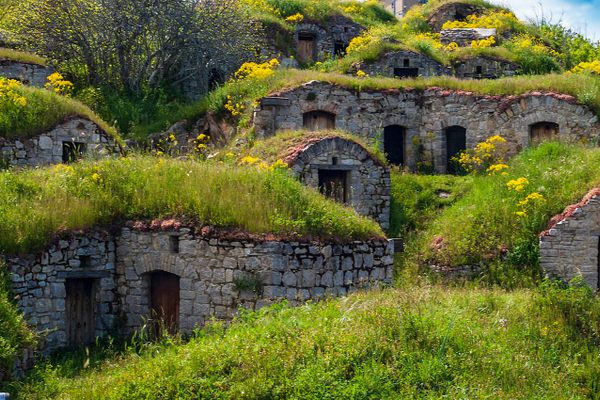The Tuscan Town Famous for Anarchists, Marble, and Lard
Now gourmet, lardo di Colonnata once fed miners in Michelangelo’s favorite quarries.
At first glance, the Apuan Alps of northwest Tuscany’s Carrara region are pure white. Alison Leitch first saw them from a train window when traveling through Italy in the early 1980s. From a distance, she writes, their dazzling tops looked like snow. Her seatmate told her otherwise: The blinding whiteness was actually marble dust, a powdery byproduct of the famous quarries that gash through the mountains. Then Leitch’s seatmate explained that the Apuan quarries were the source of another legendary tradition. “That’s where the anarchists live,” she said.
Most travel guides to Carrara will tell you the town is famous for three things: marble, anarchism, and pig fat. This unlikely trio is intertwined as deeply as the mineral veins striating the mountains. Since ancient Roman times, Carrara’s Apuan Alps have supplied marble for some of the world’s most prized sculptures. Carrara is the marble of Michelangelo’s Pietà, of Jean-Antoin Houdin’s George Washington, and New Delhi’s vast Akshardham Temple. The stone, writes Leitch, is prized for its luminosity, its networks of blue veins, and its Rorschach blots of greyish-purple. In solid blocks, it can support monoliths; in thin slabs, it can be winnowed down to translucence.
But quarrying it is dangerous business. Extracting ancient, fossilized bones from vast mountains is body-breaking work, ruining laborers’ backs and filling their lungs with powdery calcium carbonate. Accidents are common and often fatal. Since 2016, at least three workers have been crushed to death. When Leitch, now a lecturer in sociology at Macquarie University in Australia, interviewed workers in the region in the 1980s, they detailed a dangerous history. “The marble of Carrara is not white: it is red, tinged with the color of human blood,” a quarry worker told her. These harsh conditions have long bred working-class activism, including one of Italy’s most enduring anarchist traditions.

Harsh conditions also bred the region’s most famous delicacy. Now considered gourmet, lardo di Colonnata—named after the Carrara village where the salumi is most famously produced—began its life as a calorie-rich food for quarry workers. Traditionally made from the back fat of local pigs, lardo is cured in caskets of marble, called conche. Like the marble, lardo is pearly white veined with pink, the color not of human blood but pork flesh. This resonance between lard and marble is more than visual: It is a living connection, forged by the labor of quarrying and imbued into the lardo through its method of curing. “Lardo breathes marble,” says Simone Cinotto, Associate Professor of Contemporary History at the University of Gastronomic Sciences of Pollenzo.
In Carrara today, these intertwined histories are immediately apparent. Marble monuments to fallen quarry workers and anarchist struggles intermix with local shops selling lardo. On the first of May, a historically leftist holiday, Carrara celebrates an annual anarchist festival; every summer, locals feast during an annual festival of lardo. Today’s Carrara, however, hosts something you’d be unlikely to see in decades past: tourism.
There’s still less tourism in Carrara than in the rest of Tuscany, says Marco Manfredi, a historian of Italian anarchism who grew up in Carrara and is now based at L’Istituto Storico della Resistenza e della Società Contemporanea nella Provincia di Livorno. Yet driven partly by the region’s connection to art history, and partly by the newfound gourmet status of lardo di colonnata, the past decades have witnessed increasing international interest in Carrara, and in the salume endemic to it. A working-class food from a region characterized by harsh labor and anarchism seems an unlikely candidate for global gourmet fame. But like most other aspects of the region’s history, lardo’s journey from workman’s lunch to coveted artisanal product is intimately tied to marble.

Working-class foods leave light traces on the historical record, so it’s hard to know exactly how long Carrara residents have been eating lardo. Cinotto guesses at least five centuries. Until recently, the salume was not sold in stores, but made by local families, most of whom could afford to keep a pig and a vegetable garden. The pigs were fed scraps and slaughtered before Christmas, their fat cut into slabs, salted, spiced, and cured in marble conche. As the fat aged for at least six months, it sweat out its own brine. Finally, it emerged unctuous-sweet, musky, and ready to be shaved into slabs and eaten with rough bread, raw onions, and sliced tomatoes for quarry workers’ lunches. For locals, lardo di colonnata is associated with memories of poverty and pride. “Your lardo embodied your persona, because that was the pig you fed for an entire year,” says Cinotto. “It was, in a way, your fat.”
Carrara’s workers needed more than just pig fat to keep them going. They turned to radical politics. At the end of the 19th century, Italian anarchism was on the rise. In dialogue with a wave of mid-century radical thinking by the likes of Russian anarchist Mikhail Bakunin, charismatic Italian anarchists such as Errico Malatesta and Pietro Gori rejected the party-orientedness of Italian communism and channeled popular peasant culture to appeal directly to workers. They found politically fertile ground in the rugged peaks of Carrara. “A Stronghold of Anarchists,” blared one New York Times headline from January 1894. “Thousands of desperate men, engaged in the marble industry, ready for revolution.”
On January 13, 1894, in response to a socialist uprising in Sicily and simmering tensions within marble worksites, Carrara’s quarry workers revolted. “Two companies of soldiers were called out and a mob of workingmen gathered to resist them,” the Times reported. “The prevalence of Anarchism in the marble district near the towns excites much apprehension. A violent outbreak may come at any time.”

The rebellion was crushed by the Italian government, but that repression only helped cement the town’s reputation as an anarchist hotbed. “People who had an indistinct sentiment and attitude of rebellion started to define themselves as anarchists,” says Manfredi. He attributes the success of anarchist ideology in the quarries to a general mistrust of power, fueled by the region’s isolation and harsh conditions in the quarrying industry. Carrara wasn’t the only mining district that proved amenable to anarchist ideas. By World War I, anarchist workers from industrial centers across Italy were united in a national union. While the cultural legacy of this period has lingered, its political success was short-lived: Anarchism’s influence in Italian politics faded during fascism, never again reaching its early 20th-century peak.
Today, some food and tourism writers refer to lardo as “the food of anarchists,” in reference to this history. Leitch has never heard it described this way by quarry workers, not all of whom had libertarian leanings. “Some quarry workers were communists, republicans, Christian democrats, and, unfortunately, some were also fascists,” writes Leitch in an email. But Carrara’s quarry workers and radical politics are so deeply connected that lard and anarchism have become entwined in popular imagination.
Ironically, these traditions only came to the notice of tourists when the marble industry that inspired them was already in decline. When Alison Leitch returned to Carrara in the late 1990s, she found the region starkly transformed. The price of marble was low and unemployment was high, part of a wave of deindustrialization that had been sweeping Italy since the late 1980s. With the decline of the marble industry came a crisis of local culture. “An entire civilization was basically gone in a matter of a few years,” says Cinotto.

Along with deindustrialization, Italy’s traditional food cultures faced new challenges. When the country joined the European Union, many Italians experienced a crisis of culinary identity. Right-wing E.U. skeptics pointed to the standardization of agriculture coming from Brussels, including the much-parodied (and much-exaggerated) “banana curvature laws,” as the harbinger of a new era of bureaucratic excess. At the same time, the Italian left objected to the homogenizing force of globalization, signified by the increasing popularity of American-style fast food. In 1989, a group of activists, led by Italian leftist Carlo Petrini, founded Slow Food, a non-profit organization dedicated to the pleasure and politics of non-corporate, non-industrialized, local food.
When local police, in accordance with new European Union food safety standards, quarantined the lardo stores of an acclaimed local maker in 1996, Slow Food sprang into action. Declaring lardo di Colonnata endangered, the organization partnered with locals to save the salume’s traditional mode of preparation. In the process, their campaign made the once-obscure local food—whose unctuousness had historically elicited disgust among the upper classes—famous. Ironically, in the course of spreading the gospel of lardo, Slow Food’s campaign also spawned imitators: large charcuterie shops in big Italian cities and other global centers who gave their cured meats the lardo di Colonnata name. To combat this, local producers vied for, and eventually won, Protected Geographical Indication (IGP) designation from the European Union, which stipulates that at least one step in lardo’s production must take place in Carrara.

Today, visitors to Carrara can find an anarchist organization, monuments to quarry workers’ political struggles, and, of course, lardo. Lardo’s popularity, and the tourism industry it helped encourage, is a mixed blessing: Saved from death by overregulation, lardo’s production has nevertheless been taken out of the hands of local households, says Manfredi. At the same time, the shift toward tourism embodied in lardo’s newfound fame represents Italy’s broader transition away from industrial economies—a transition Manfredi feels has left some working-class locals in the lurch. As for the region’s connection to radical politics, it’s only now, when the violent repression of workers’ revolts is a distant memory, that this history, too, can become a tourist attraction. “There’s kind of an oblivion of memory that makes even the story very paradoxically consumable,” Cinotto says.
Still, protected by its IGP status, lardo di Colonnata remains rooted in the land of its birth. Melting in lush slivers on toasted Italian bread, or eaten with the classic raw onion and tomato, genuine lardo remains white and pink as the conche it is cured in. Some of Carrara’s miners, Leitch writes, believe the stone they quarry has an anima, a living spirit. Michelangelo’s Pietà may be the most celebrated work of art to come from Carrara’s marble, but it is, perhaps, pork fat that best embodies the marble’s soul.
Gastro Obscura covers the world’s most wondrous food and drink.
Sign up for our regular newsletter.






























Follow us on Twitter to get the latest on the world's hidden wonders.
Like us on Facebook to get the latest on the world's hidden wonders.
Follow us on Twitter Like us on Facebook